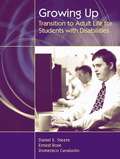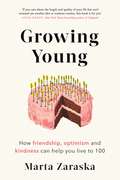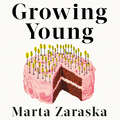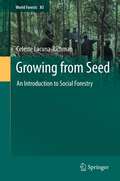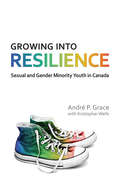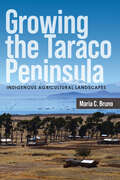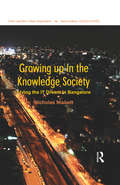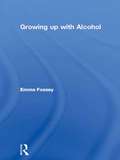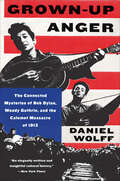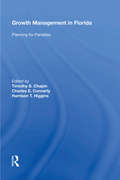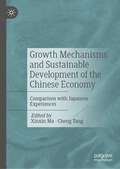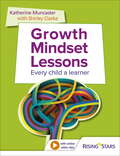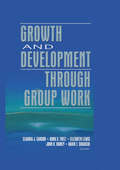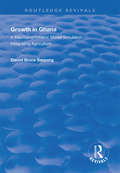- Table View
- List View
Growing Up: Transition to Adult Life for Students with Disabilities
by Daniel E. Steere Ernest Rose Domenico CavaiuoloCase studies of students with mild and severe disabilities are followed throughout the book to illustrate effective practices that are described. Through case studies and clearly presented content, this book helps readers learn what they can do to assist students with disabilities in achieving positive adult outcomes.
Growing Young: How Friendship, Optimism and Kindness Can Help You Live to 100
by Marta Zaraska'If you care about the length and quality of your life but can't stomach yet another diet or workout routine, this book is for you' - Adam Grant, New York Times bestselling author 'Finally, a lifestyle book that transcends diet and exercise for solutions for living longer' - Dan Buettner, National Geographic Fellow and New York Times bestselling author A smart, research-driven case for why optimism, kindness and strong social networks will help us live to 100.What to do to live long? From fountain-searching Ponce de Leon to pill-popping Silicon Valley techies humanity has been trying to pinpoint the answer for centuries, often fixating on all the wrong things: miracle diets, miracle foods, miracle supplements. We skip gluten and invest in exercise gadgets. We swallow vitamins. We obsess about BMI. While healthy nutrition and physical activity are indeed important for health, there are things we all too often sacrifice in favour of fad diets that have an outsize impact on our centenarian potential. Friendships. Purpose in life. Empathy. Kindness. Science shows that these 'soft' health drivers are often more powerful than diet and exercise.Consider the numbers: studies show that building a strong support network of family and friends lowers mortality risk by about 45 per cent. Exercise, on the other hand, can lower that risk by 23 to 33 per cent. Eating six servings of fruit and veg per day can cut the danger of dying early by 26 per cent, while following the Mediterranean diet by 21 per cent. For volunteering, it's 22 to 44 per cent. Many more examples like this led Marta Zaraska to her ultimate conclusion: you should be contemplating your purpose in life, not the best fitness tracker to buy.Humans are social animals. Over the course of our evolution we've developed intertwined systems that regulate our social lives on one hand and our physiology on the other, contributing to our centenarian potential. The amygdala and the insula in the brain, the social hormones oxytocin and serotonin, the vagus nerve, the HPA stress axis - these all link our bodies and our minds, contributing to our centenarian potential. We feel safe when we are surrounded by friendly others. The nervous system, the gastrointestinal system, the immune system all function properly when the tribe is there for us and when we are there for the tribe. We flourish as part of a group.Marta Zaraska based Growing Young on hundreds of research papers and on interviews with dozens of leading scientists from fields as diverse as molecular biochemistry, cyber psychology, marketing and zoology. The book's research took her to rather unexpected places, too: catching wild mice in the woods of England, sipping super-smoothies at a longevity bootcamp in Portugal and arranging flowers with octogenarians in Japan. In the end, all the studies, the interviews and the travels brought her to a simple conclusion: self-improvement, commitment to growing as a person, can also help us grow younger. To Michael Pollan's famous statement on health: 'Eat food, not too much, mostly plants,' she now adds: 'Be social, care for others, enjoy life.'
Growing Young: How Friendship, Optimism and Kindness Can Help You Live to 100
by Marta Zaraska'If you care about the length and quality of your life but can't stomach yet another diet or workout routine, this book is for you' - Adam Grant, New York Times bestselling author 'Finally, a lifestyle book that transcends diet and exercise for solutions for living longer' - Dan Buettner, National Geographic Fellow and New York Times bestselling author A smart, research-driven case for why optimism, kindness and strong social networks will help us live to 100.What to do to live long? From fountain-searching Ponce de Leon to pill-popping Silicon Valley techies humanity has been trying to pinpoint the answer for centuries, often fixating on all the wrong things: miracle diets, miracle foods, miracle supplements. We skip gluten and invest in exercise gadgets. We swallow vitamins. We obsess about BMI. While healthy nutrition and physical activity are indeed important for health, there are things we all too often sacrifice in favour of fad diets that have an outsize impact on our centenarian potential. Friendships. Purpose in life. Empathy. Kindness. Science shows that these 'soft' health drivers are often more powerful than diet and exercise.Consider the numbers: studies show that building a strong support network of family and friends lowers mortality risk by about 45 per cent. Exercise, on the other hand, can lower that risk by 23 to 33 per cent. Eating six servings of fruit and veg per day can cut the danger of dying early by 26 per cent, while following the Mediterranean diet by 21 per cent. For volunteering, it's 22 to 44 per cent. Many more examples like this led Marta Zaraska to her ultimate conclusion: you should be contemplating your purpose in life, not the best fitness tracker to buy.Humans are social animals. Over the course of our evolution we've developed intertwined systems that regulate our social lives on one hand and our physiology on the other, contributing to our centenarian potential. The amygdala and the insula in the brain, the social hormones oxytocin and serotonin, the vagus nerve, the HPA stress axis - these all link our bodies and our minds, contributing to our centenarian potential. We feel safe when we are surrounded by friendly others. The nervous system, the gastrointestinal system, the immune system all function properly when the tribe is there for us and when we are there for the tribe. We flourish as part of a group.Marta Zaraska based Growing Young on hundreds of research papers and on interviews with dozens of leading scientists from fields as diverse as molecular biochemistry, cyber psychology, marketing and zoology. The book's research took her to rather unexpected places, too: catching wild mice in the woods of England, sipping super-smoothies at a longevity bootcamp in Portugal and arranging flowers with octogenarians in Japan. In the end, all the studies, the interviews and the travels brought her to a simple conclusion: self-improvement, commitment to growing as a person, can also help us grow younger. To Michael Pollan's famous statement on health: 'Eat food, not too much, mostly plants,' she now adds: 'Be social, care for others, enjoy life.'
Growing a Japanese Science City: Communication in Scientific Research (Nissan Institute/Routledge Japanese Studies)
by James W. DearingTsukuba Science City is the world's most ambitious attempt to `turbocharge' scientific collaboration. James W. Dearing looks at the political and economic context within which the plans for Tsukuba were laid, how those plans changed during the process of implementation, and at the functioning of Tsukuba today. Tsukuba is vitally important to Japan's basic scientific research . Its history, its failures and successes need to be understood by governments and businesses planning for scientific research and economic growth.
Growing from Seed
by Celeste Lacuna-RichmanSocial Forestry and its most well-known variant, Community Forestry, have been practiced almost as long as people have used forests. During this time, forests have provided people with countless goods and services, including wood, medicine, food, clean water and recreation. In making use of forest resources, people throughout history have frequently organized themselves and established both formal and informal rules. However, just as the discipline of Forestry had previously limited and concentrated the function of forests to the timber it provides, the popular understanding of Social Forestry has restricted it to a Forestry sub-topic that deals with welfare, without any connection to income-generation, and is practiced only in developing countries. This volume introduces the concepts of Social Forestry to the student, gives examples of its practice around the world and attempts to anticipate developments in its future. It aims to widen the concept of Social Forestry from a sub-practice within Forestry to a practice that will make Forestry relevant in countries where wood production alone is no longer the main reason for keeping land forested, thereby rediscovering and redefining this important topic.
Growing into Resilience
by Andre P. Grace Kristopher WellsDespite recent progress in civil rights for sexual and gender minorities (SGM), ensuring SGM youth experience fairness, justice, inclusion, safety, and security in their schools and communities remains an ongoing challenge. In Growing into Resilience, André P. Grace and Kristopher Wells - co-founders of Camp fYrefly, a summer leadership camp for SGM youth - investigate how teachers, healthcare workers, and other professionals can help SGM youth build the human and material assets that will empower them to be happy, healthy, and resilient.Grace and Wells investigate the comprehensive (physical, mental, and sexual) health of SGM youth, emphasizing the role of caring professionals in an approach that that recognizes and accommodates SGM youth. Throughout, the authors draw upon the personal narratives of SGM youth, emphasizing how research, policy, and practice must act together for them to be able to thrive and fulfill their promise.Both a resource for those professionally engaged in work with sexual and gender minorities and a comprehensive text for use in courses on working with vulnerable youth populations, Growing into Resilience is a timely and transdisciplinary book.
Growing the Taraco Peninsula: Indigenous Agricultural Landscapes
by Maria C. BrunoGrowing the Taraco Peninsula is an examination of long-term human-environmental interactions through agriculture among Indigenous communities of the Taraco Peninsula, Bolivia, located on the shores of Lake Titicaca in the Andes. Maria Bruno weaves together ethnographic observations of modern-day Aymara farming practices with an in-depth study of archaeological remains, particularly plants, to examine the development of agricultural landscapes through time. Beginning with the first small-scale communities of the Formative period (1500 BCE–500 CE) through the development of the Tiwanaku state (500–1100 CE), Bruno draws upon ethnographic insights from modern-day Indigenous farming practices on the peninsula as well as archaeological evidence from excavations at four sites to explore the landscapes and human-plant relationships that Taraco communities created through their agricultural practices. Through evaluation of environmental data on climate and land-use dynamics—rainfall, lake level, and soil character and distribution—she proposes a new hypothesis of how raised-field agriculture may have emerged in the region. With a detailed analysis of foodways at the Kala Uyuni site, her study reveals how Indigenous Taraco communities sustainably incorporated crops and wild plants into their daily and special-occasion meals, connecting the agricultural landscapes to local and regional social and political dynamics. Bringing together several indicators of the region’s long-term history and demonstrating that shifts in agriculture do not neatly correspond to the changes traditionally highlighted by archaeological culture histories, Growing the Taraco Peninsula reveals Indigenous landscape creation through farming on the Taraco peninsula as a critical example of sustainability. This valuable contribution to Andean archaeology is also of interest to scholars, students, and the general reader concerned about the environment, sustainable farming, sustainability, Andean history, and the Indigenous peoples of the Americas.
Growing up Female in Multi-Ethnic Malaysia (ASAA Women in Asia Series)
by Cynthia JosephThis book provides a rich, detailed analysis of the experiences of young women growing up in post-colonial, rapidly modernizing Malaysia. It considers the impact of ethnicity, socio-economic status, and school experiences and achievement. It discusses the effects of Malaysia’s ethnic affirmative action programmes and of the country’s Islamisation. It sets out and compares the life trajectories of Malay, Indian and Chinese young women, making use of interview and questionnaire data gathered over a long period. It thereby depicts individuals’ transformations as they experience maturing into adulthood against a background of social and economic changes, and varying levels of inter-racial tension.
Growing up in the Knowledge Society: Living the IT Dream in Bangalore (Cities And The Urban Imperative Ser.)
by Nicholas NisbettThis work is an ethnographic investigation into the everyday lives of young people growing up and living in contemporary Bangalore. Moving beyond the hype of the Indian ‘knowledge society’, it examines how new forms of technology and outsourced labour become integral to their lives, changing the experience of Indian modernity and globalisation.
Growing up with Alcohol
by Emma FosseyThe use and misuse of alcohol by young people is an established concern. Initiatives designed to educate the young about the potential dangers of alchol are frequently directed solely at teenagers. Growing up with Alcohol argues that this may be leaving it too late. Emma Fossey presents a detailed account of a study of children aged between five and ten years, carried out through a series of ingenious game-like activities. She explodes the myth that young children are ignorant about alcohol and provides valuable insights about how very young children learn about alcohol and about their early perceptions of alcohol. The study questions the effectiveness of past alcohol education and argues strongly that future initiatives should develop innovative and user-friendly alcohol education materials for use in primary as will as in secondary schools and colleges.
Growing up with Parents who have Learning Difficulties
by Tim Booth Wendy BoothGrowing up with Parents who have Learning Difficulties uses a life-story approach to present new evidence about how children from such families manage the transition to adulthood, and about the longer-term outcomes of such an upbringing. It offers a view of parental competence as a social attribute rather than an individual skill, assessing the implications for institutional policies and practices. The authors address the notion of children having to parent their disabled parents and argue for a shift in emphasis from protecting children to supporting families.This innovative book provides a fresh approach to a subject rife with prejudice and challenges us to think again about many taken-for-granted ideas about the process of parenting and the needs of children. It also demonstrates the power of narrative research and its capacity for bringing alive people's experience in a way that enables us to better understand their lives.
Grown-Up Anger: The Connected Mysteries of Bob Dylan, Woody Guthrie, and the Calumet Massacre of 1913
by Daniel WolffA brilliantly intertwined account of two revolutionary musicians, a miners’ strike, and a deadly tragedy: “Reads like a historical detective story.” —The New York Times Book ReviewAt thirteen, when he first heard Bob Dylan’s “Like a Rolling Stone,” Daniel Wolff recognized the sound of anger. When he later discovered “Song for Woody,” Dylan’s tribute to folk musician Woody Guthrie, Wolff fixed on it as a clue to a distinctive mix of rage and compassion. That clue led back to Guthrie’s “1913 Massacre”—a memorial song about the horrific conclusion to a union Christmas party in Calumet, Michigan.Following the trail from Dylan to Guthrie to a tragedy that claimed seventy-four lives, Wolff found himself tracing a century-long line of anger. From America’s early industrialized days up to the present, the battle over economic justice keeps resurfacing: on a freight car in California, on a joyride through New Orleans, in a snowy field in Michigan. At the stunning conclusion—as the mysteries of Dylan, Guthrie, and the 1913 tragedy connect—the reader discovers a larger story, purposely distorted and buried in time.A tour de force of storytelling years in the making that chronicles the struggles between the haves and have-nots, Grown-Up Anger is both a dual biography of two legendary songwriters and a murder mystery. It also serves as a history of labor relations and socialism, big business and greed in twentieth-century America—all woven together in one epic saga.“A fascinating and relevant whirlwind examination of music, economic injustice, and two American icons.” —Booklist (starred review)“A masterful tale of music, social, and economic history . . . A dazzling, richly researched story impeccably told.” —Kirkus Reviews (starred review)
Growth Cultures: The Global Bioeconomy and its Bioregions (Genetics And Society Ser.)
by Philip CookeThis groundbreaking book is the first comparative analysis of the relative strengths of global bioregions. Growth Cultures investigates the rapidly growing phenomena of biotechnology and sets this study within a knowledge economy context. Philip Cooke proposes a new knowledge-focused theoretical framework, ‘the New Global Bioeconomy’, against which to test empirical characteristics of biotechnology. In this timely volume, Cooke unifies concepts from the sociology of science, economic sociology and evolutionary economic geography to focus on the problems and prospects for policy agencies worldwide trying to build ‘biotechnology clusters’. He develops a superior policy approach of thinking in terms of platforms that integrate proximities and pipelines, which will be of significant interest for the scientific and technological communities as well as economic development policy communities. Growth Cultures will make fascinating reading for students, policy makers and researchers across management and business studies, innovation and knowledge studies, sociology, science and technology policy, applied economics, development studies and regional science.
Growth Management in Florida: Planning for Paradise (Urban Planning And Environment Ser.)
by Timothy S.ChapinDespite its historical significance and its state-mandated comprehensive planning approach, the Florida growth management experiment has received only piecemeal attention from researchers. Drawing together contributions from national experts on land use planning and growth management, this volume assesses the outcomes of Florida‘s approach for managing growth. As Florida‘s approach is the most detailed system for managing growth in the United States, this book will be of great value to planners. The strengths and weaknesses of the state‘s approach are identified, providing insights into how to manage land use change in a state continuously inundated by growth. In evaluating the successes and failures of the Florida approach, planners and policy makers will gain insights into how to successfully implement growth management policies at both the state and local level.
Growth Mechanisms and Sustainable Development of the Chinese Economy: Comparison with Japanese Experiences
by Xinxin Ma Cheng TangWhat can Chinese economists learn from the Japanese economic boom and subsequent stagnation? This project aims to institutionally and empirically investigate the growth mechanism and determinants of sustainable development in China compared with Japanese experiences. This is the first challenge in conducting a comparative study on China and Japan’s economic growth and development. We aim to investigate the economic system transition and its influence on the Chinese and Japanese economy from macroeconomic and microeconomic perspectives. This book will interest economists, scholars of comparative politics, and scholars of China or Japan's economic development.
Growth Mindset Lessons: Every Child a Learner
by Shirley Clarke Katherine MuncasterPractising teacher and mindset expert Katherine Muncaster has combined with best-selling author Shirley Clarke to produce this 'must-have' handbook for anyone looking to embed a growth mindset culture across their primary school. With practical strategies, lesson plans and extensive examples and realia in full colour, this comprehensive resource takes the concept of growth mindset and turns it into a powerful reality. · A comprehensive and practical scheme of work which will develop a powerful learning culture throughout your school· A tangible way to put growth mindset into action which has been developed, tested and trialled by Katherine Muncaster· Co-authored by leading professional development expert Shirley Clarke· Supported by easy-to-access classroom video clips that provide demonstrations of the impact of this approach in lessons.
Growth Mindset Lessons: Every Child a Learner
by Shirley Clarke Katherine MuncasterPractising teacher and mindset expert Katherine Muncaster has combined with best-selling author Shirley Clarke to produce this 'must-have' handbook for anyone looking to embed a growth mindset culture across their primary school. With practical strategies, lesson plans and extensive examples and realia in full colour, this comprehensive resource takes the concept of growth mindset and turns it into a powerful reality. · A comprehensive and practical scheme of work which will develop a powerful learning culture throughout your school· A tangible way to put growth mindset into action which has been developed, tested and trialled by Katherine Muncaster· Co-authored by leading professional development expert Shirley Clarke· Supported by easy-to-access classroom video clips that provide demonstrations of the impact of this approach in lessons.
Growth Triumphant
by Richard A. EasterlinTaking a longer view than most literature on economic development, Richard A. Easterlin stresses the enormous contrast between the collective experience of the last half century in both developed and developing countries and what has gone before. An economic historian and demographer, the author writes in the tradition of the "new economic history," drawing on economic theory and quantitative evidence to interpret the historical experience of economic theory and population growth. He reaches beyond the usual disciplinary limits to draw, as appropriate, on sociology, political science, psychology, anthropology, and the history of science. The book will be of interest not only to social scientists but to all readers concerned with where we have been and where we are going. ". . . Easterlin is both an economic historian and a demographer, and it is the combination of these two disciplines and the fine balance between theory and experience that make this well-written, refreshingly optimistic book excellent reading. " --Population and Development Review "In this masterful synthesis, Richard Easterlin draws on the disciplines of economic history, demography, sociology, political science, psychology, and the history of science to present an integrated explation of the origins of modern economic growth and of the mortality revolution. . . . His book should be easily accessible to non-specialists and will give them a sense of why economic history can inform our understanding of the future. " --Dora L. Costa, Massachusetts Institute of Technology, EH. Net and H-Net "Growth Triumphant is, simply, a fascinating book. Easterlin has woven together a history of economic growth, economic development, human mortality and morbidity, the connections each has with the others, and the implications of this nexus of forces on the future. . . . This book deserves a wide audience. " --Choice "In what must surely be the most fair-minded, well-balanced, and scrupulously reasoned and researched book on the sensational subjects implied in its title--the Industrial Revolution, the mortality and fertility revolutions, and the prospects for future happiness for the human race--Professor Easterlin has set in place the capstone of his research career. " --Journal of Economic History Richard A. Easterlin is Professor of Economics, University of Southern California.
Growth and Capital Flows with Risky Entrepreneurship
by Damiano SandriA report from the International Monetary Fund.
Growth and Change in Post-socialist Cities of Central Europe (Routledge Contemporary Perspectives on Urban Growth, Innovation and Change)
by Cudny Waldemar Kunc JosefThis book presents multidimensional socio-economic transformations taking place in the post-socialist cities located in selected countries of the Central European region. The analysis includes case studies from the Eastern part of Germany (Chemnitz, Leipzig), Poland (Łódź, Kielce, Katowice conurbation, and peripheral urban centres from Eastern Poland), Slovakia (Bratislava, Nitra), the Czech Republic (Olomouc, Brno), and from Hungary (Pécs). The analysed urban areas have undergone far-reaching political and socio-economic changes in the last 30 years. These changes began with the collapse of communism and the centrally planned economy system in the region of Central Europe. The beginning of this period, often referred to as post-socialist transformation, dates back to 1989. The consequence of the aforementioned political processes was the multifaceted socio-economic and demographic changes that significantly affected urban areas in Central Europe. This book presents an attempt to summarize the main long-term processes of changes taking place in these urban areas and to identify contemporary and future trends in their socio-economic development. The book will be valuable to undergraduate and postgraduate students in human geography, urban studies, economy, and city marketing, especially with an interest in Central Europe.
Growth and Development Through Group Work
by Elizabeth Lewis Claudia Carson Anna FritzExamine group work's roots and fundamental beliefs to get a glimpse of the future For more than 80 years, social group work has survived difficult times-a testament to the persistence of its practitioners as well as the strength of its methods. Growth and Development Through Group Work chronicles the evolution of this groundbreaking practice through a collection of peer-reviewed papers presented at the 23rd Annual International Symposium on Social Work with Groups. The book examines practice, policy, and education issues in specific settings and populations from both theoretical and historical perspectives. Presented in the wake of the September 11 terrorist attacks in New York City and Washington, DC, the papers that comprise Growth and Development Through Group Work reflect a heightened awareness of the importance of social action group work-now, and in the future. The book represents the best of social work&’s tradition of social reform and concern for oppressed people, never straying far from the concept of the group, with its multiple helping relationships, as the primary source of change. A comprehensive overview of the field in international, intercultural, and cross-gender contexts, Growth and Development Through Group Work is equally effective for coursework or independent reading. Topics addressed in Growth and Development Through Group Work include: contributions of the late Ruby B. Pernell to the development of social group work research in support of group work education and practice group work in Germany-its development from American roots and its current advances social justice as a major objective of group work practice teaching group work mutual aid in support groups for particularly sensitive health problems psychoeducational group work contributions from Hull House as guides for the future of social group workGrowth and Development Through Group Work is an invaluable resource for clinicians, neighborhood and community activists, educators and students, researchers, therapists, administrators, and anyone working in policy and/or program development.
Growth and Intimacy for Gay Men: A Workbook
by Christopher J AlexanderGrowth and Intimacy for Gay Men: A Workbook is an educational workbook for gay men that covers a variety of topics, including family of origin, addiction, self-image, dating and relationships, AIDS and multiple loss, and spirituality. Each chapter provides an overview of the mental health concerns of gay men, as well as exercises the reader can do to facilitate his personal understanding of the issues covered. While the book is written in nontechnical language, making it useful to the general public, its wide selection of workbook exercises makes it useful for psychotherapists and counselors working with gay men. Growth and Intimacy for Gay Men is written to the reader--with brief examples from the author’s work as a clinical psychologist helping gay men. A central goal of the book is to normalize the feelings and experiences the reader has, as many gay men feel like they’re the only ones with their feelings or experiences. The book’s problem-solving approach addresses: family of origin--provides exercises to identify and examine gay men’s role in the family, examine their childhood perceptions of being different, and help them map out family patterns and dynamics self-image--includes self-image assessment questionnaires and written exercises that challenge the reader to look at how they’re affected by societal perceptions addiction--explores why gay men are vulnerable to addictive behavior and offers strategies for change and self-assessment exercises dating and relationships--covers the unique challenges faced by gay men, with exercises for single as well as coupled men AIDS and mental health--provides exercises to help the reader examine the impact of AIDS on his own life and to assess the impact of multiple loss and prolonged grief Readers can do the workbook exercises on their own, or therapists can assign chapters and exercises as homework, with clients bringing the completed assignment to therapy for more in-depth exploration and discussion. By providing informative chapters and useful exercises, Growth and Intimacy for Gay Men becomes an avenue through which gay men can understand their identity, experiences, and goals.
Growth and Intimacy for Gay Men: A Workbook
by Christopher J. AlexanderGrowth and Intimacy for Gay Men: A Workbook is an educational workbook for gay men that covers a variety of topics, including family of origin, addiction, self-image, dating and relationships, AIDS and multiple loss, and spirituality. Each chapter provides an overview of the mental health concerns of gay men, as well as exercises the reader can do to facilitate his personal understanding of the issues covered. While the book is written in nontechnical language, making it useful to the general public, its wide selection of workbook exercises makes it useful for psychotherapists and counselors working with gay men.
Growth in Ghana: A Macroeconometric Model Simulation Integrating Agriculture (Routledge Revivals)
by Daniel Bruce SarpongPublished in 1997, this text is set in a context where Ghana has experienced improvements in aggregate output performance over the past decade (1986-1996) yet agriculture's performance remains sub-optimal. The author focuses on agriculture's fragmentation as attributable to space (storage, transportation and marketing), form (rudimentary production methods in general) and content (stagnent productivity and poor organization of production) and notes that whilst current policies have impinged on the space fragmentation, issues on form and content seem to have been left to the dictates of the market. The author calls for a strategy of government plan in promoting modern technology in agriculture to enhance its linkage to industry for rapid and sustainable economic growth.
Growth or Stagnation?: South Africa Heading for the Year 2000 (Routledge Revivals)
by Mats LundahlFirst published in 1999, the essays collected in the present volume derive from an interest in South Africa and its economy which goes back to the early 1970s and were written between 1994 and 1999. The intention is to follow how the debate on the South African economy has evolved since the fall of the apartheid regime. Issues discussed include the South African economy after apartheid and whether the new South African economy is ultimately experienced growth or stagnation.
